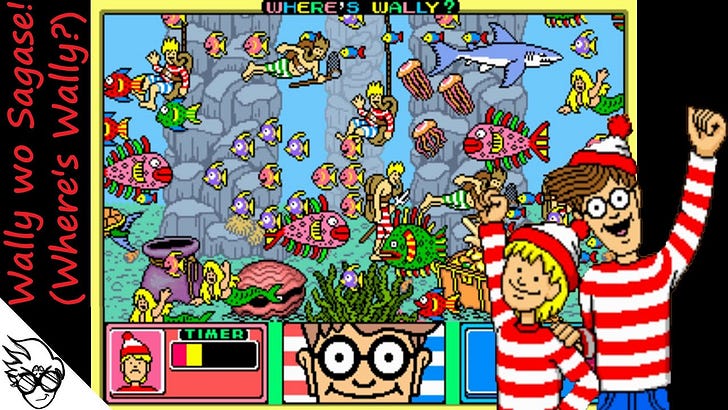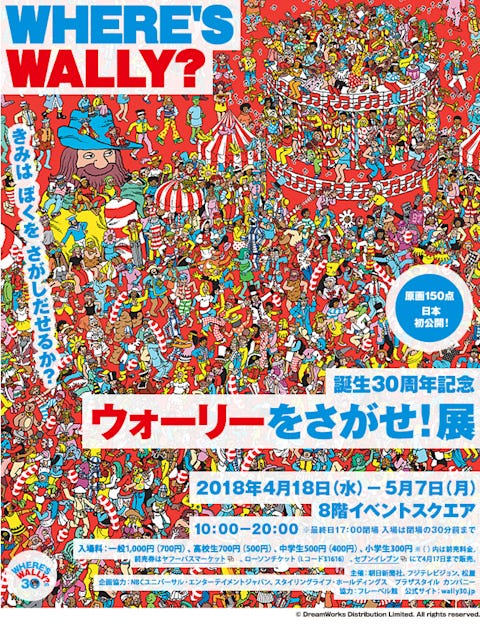The the world’s longest ongoing hide and seek game started in 1987. There and then a curious beanie-capped man with extreme style co-ordination became the focus of millions of eyes, searching for him amongst the crowd. Along the way he gained an entourage of similarly clothed people (and a dog), but to this day he remains the star of the show. I speak of course of the wily man himself, Wally, or as his American alias suggests, Waldo. This search party has become not simply a national investigation, but has crossed into the international realm.
Wally’s first days
Wally waltzed into Japan like anyone else. Unassuming and unremarkable. He had arrived very soon after his debut in the UK, travelling in the same year to Japan under his real, if not Japanified, name of (ウォーリー) or Wally (Wōrī). Side note that this is the same name given to a Pixar robot in 2009, who frequently is found in the same shops that sell Wally merchandise. To find the merchandise, you might need to ask… Where’s Wally?, not Wall-E, Where’s Where’s Wally? or just the classic ウォーリーをさがせ! Wally stayed Wally in Japan despite his frequent aliases like Waldo in the USA, Walter in Germany and most suspiciously Charlie in France.
It seemed like the late 1980’s were a difficult time to be a child, as the Where’s Wally books sold incredibly well everywhere. Perhaps in their search for an escape from everyday drudgery, the search for Wally, was exciting?
The Wally series started off with a bang, selling 2.3 Million copies across Japan. That is counting only the original ウォーリーをさがせ! run. Subsequent copies kept selling well, yet with a slight dip in each era to the final 7th book (ウォーリーをさがせ! 謎のメモ大追跡!) or Wally’s secret note, which sold 110,000 copies still. After a while, there were enough books around that if you were looking for Wally, you’d find him.
While the books success could explain the cultural phenomenon of Wally, we need to examine the surrounding merchandise and cross-licensing that has created the long-lasting fascination with this beanied man.
Wally’s Game
Perhaps the only way Where’s Wally could be worse for your eyes is if it was a digital search. Luckily, Japan decided that was exactly what their youth needed in 1992. Thus, the Where’s Wally arcade game was developed by Sega. See for yourself on how to most effectively damage your retinas in the video below.
The truth of Wally fandom was that the books were popular, so every Japanese media company wanted to partner with them. This snowballed into the video game, the TV show (yes, there was a short-lived show, but this was actually American), and general merchandising.
The merchandising opportunities were what launched Wally from fun Western character in the late 80’s, to enduring Japanese icon. He was and is bandied about everywhere, from the standard pencil cases to more outrageous items like ketchup bottles. He was popular, so he moved merchandise, and so he was more popular. And so it goes. Once characters hit a certain threshold of fame in Japan they become money printing licenses, and Wally reached the early heights through tactical marketing.
It’s Wally’s World
This cultural legacy has meant that Japan hosts perhaps the most Wally-related events in the world. What are Wally-related events?
Firstly, we have the cosplayers. Being one of the easier costumes, Wally is a staple across the Japanese cosplay landscape. One cosplayer begets another, so these become gatherings of thousands of Where’s-Wally-dressed people. This both recreates the original book, but defeats the purpose, as everyone actually looks like Wally. World records have been set for largest gathering of Wally lookalikes in the famous Huis Ten Bosch theme park, showing that the red and white sweater is probably a staple of the Japanese fashion scene.
Beyond cosplayers, you have themed fun runs, gallery exhibitions and crossover merchandise with everyone from Hello Kitty to One Piece. His legacy of being difficult to locate is one of conflict in Japan, as you can find him wherever you go. This success showcases how, with clever cross marketing and maybe a simple iconic uniform, you too could be the go-to reference for all things red, white and striped.






I never would have considered if Waldo - or Wally - had a presence in Japan. Was fun learning about this today!